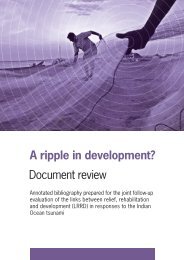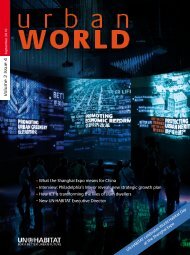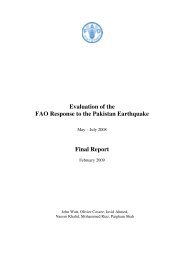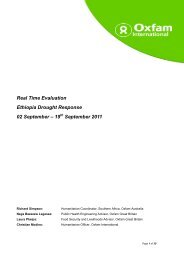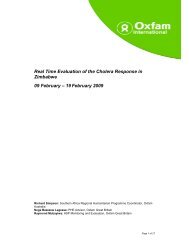Inter-Agency Real Time Evaluation of the Humanitarian ... - alnap
Inter-Agency Real Time Evaluation of the Humanitarian ... - alnap
Inter-Agency Real Time Evaluation of the Humanitarian ... - alnap
You also want an ePaper? Increase the reach of your titles
YUMPU automatically turns print PDFs into web optimized ePapers that Google loves.
IA RTE <strong>of</strong> <strong>the</strong> humanitarian response to Pakistan’s 2010 Floods crisis<br />
2010, an IA RTE is triggered if more than 1 million individuals are affected and if <strong>the</strong> Flash<br />
Appeal asks for more than 50$ million US Dollars. In <strong>the</strong> case <strong>of</strong> Pakistan, <strong>the</strong> August 2010<br />
Pakistan Initial Floods Emergency Response Plan identified <strong>the</strong> affected population as 14 million<br />
and <strong>the</strong> total funding requested was at 459$ million US Dollars.<br />
2. BACKGROUND TO THE CURRENT CRISIS<br />
Over <strong>the</strong> course <strong>of</strong> <strong>the</strong> 2010 monsoon season, Pakistan experienced <strong>the</strong> worst floods in<br />
its history.<br />
Heavy rainfall, flash floods and riverine floods combined to create a moving body <strong>of</strong><br />
water equal in dimension to <strong>the</strong> land mass <strong>of</strong> <strong>the</strong> United Kingdom. The floods have<br />
affected 84 districts out <strong>of</strong> a total <strong>of</strong> 121 districts in Pakistan, and more than 20 million<br />
people – one-tenth <strong>of</strong> Pakistan’s population – devastating villages from <strong>the</strong> Himalayas to<br />
<strong>the</strong> Arabian Sea. More than 1,700 men, women and children have lost <strong>the</strong>ir lives, and at<br />
least 1.8 million homes have been damaged or destroyed. Since heavy rainfall and flash<br />
floods claimed <strong>the</strong>ir first victims, flood waves continue to devastate <strong>the</strong> sou<strong>the</strong>rn<br />
province <strong>of</strong> Sindh, where <strong>the</strong> full extent <strong>of</strong> losses and damages may not be known for<br />
several more weeks.<br />
3. OBJECTIVES AND USE<br />
The IA RTE team will be deployed during <strong>the</strong> current response phase, ideally in January/<br />
February.<br />
The IA RTE will aim to provide snapshots <strong>of</strong> current situations, including real‐time feedback and<br />
learning to <strong>the</strong> HCT: (local IASC, Cluster, NGO’s, Government, NGO’s involved in <strong>the</strong><br />
humanitarian response – at Federal, District and Provincial level). The main objective <strong>of</strong> <strong>the</strong> IA<br />
RTE is to assess <strong>the</strong> current response to date and provide real time feedback and input into on‐<br />
going decision making in <strong>the</strong> field. This will enable <strong>the</strong> adoption <strong>of</strong> corrective actions as needed<br />
and demonstrate a visible capacity for <strong>the</strong> humanitarian system as a whole to learn lessons.<br />
The evaluation will in this way support <strong>the</strong> ongoing operational planning <strong>of</strong> <strong>the</strong> <strong>Humanitarian</strong><br />
Country Team (HCT), which will be <strong>the</strong> most immediate user <strong>of</strong> <strong>the</strong> feedback and<br />
recommendations.<br />
Riccardo Polastro, Aatika Nagrah, Nicolai Steen and Farwa Zafar<br />
63







